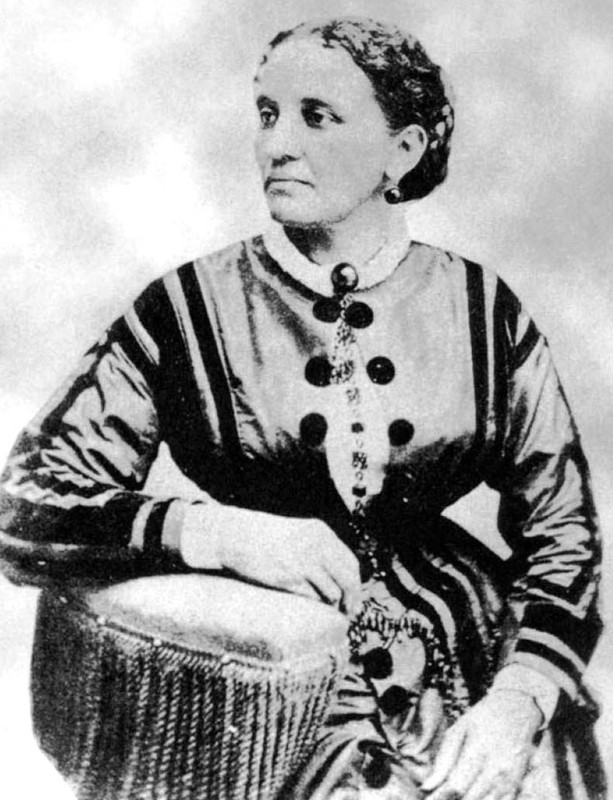1818 - 1907
By: Teri Graham | Date Added:

Elizabeth Hobbs Keckley was born in February 1818 in Dinwiddie County, Virginia. Her mother, Agnes (Aggy) Hobbs, was an enslaved woman on Colonel Armistead Burwell’s plantation. Col. Burwell was also Keckley’s biological father. The Burwells never recognized Keckley’s parentage. Aggy’s husband, George Pleasant Hobbs, an enslaved man on a nearby plantation, was devoted to Keckley and regarded her as his daughter. Keckley assisted her mother with chores in the Burwell household including cleaning, sewing, and watching over the Burwell’s young children (Keckley’s half-siblings). Unlike many enslaved people at the time, Keckley was allowed to learn to read and write. At fourteen, Keckley was sent to North Carolina to work for Col. Burwell’s son, Robert. They hired Keckley out to a white neighbor who frequently beat Keckley and forced her into a sexual relationship for four years, resulting in the birth of Keckley’s only son, George, in 1842. That same year, Keckley and her son were sent back to the Burwell plantation in Virginia. Col. Burwell then gave Keckley, her son, and Aggy to his daughter (and Keckley’s half-sister), Ann Garland, as a wedding gift. Around 1847, the Garlands moved to St. Louis to make a new start. Keckley, George, and Aggy had to accompany them. To make money, the Garlands decided to hire out Aggy to clean other white families’ houses. She used the skill her mother had taught her: sewing. Quickly earning a reputation as one of the best dressmakers, she received orders from some of the wealthiest women in the city. As an enslaved woman, Keckley’s earnings went to her owner, but Keckley made enough money to keep her mother from being hired out. In 1850, Keckley married James Keckley, an African American man whom she met in Virginia. The marriage soured and the couple formally separated in 1860. In 1852 Keckley asked the Garlands for her freedom. They initially refused, but later told Keckley they would emancipate her and her son George for $1,200. Unable to keep her own earnings, this price was impossible. As she searched for ways to raise the money, her plight caught the attention of some of her wealthy clients. They raised the money for Keckley to purchase her and George’s freedom on November 15, 1855. For the next five years, the now-free Keckley continued to work as a dressmaker in St. Louis. She made enough money to pay back everyone who had helped to secure her freedom. In 1860, Keckley and her son moved to Washington, D.C. Washington D.C. With the help of her clients in St. Louis, Keckley was able to settle in and created a new client base in the city, including Varina Davis (the wife of soon-to-be President of the Confederacy, Jefferson Davis). In 1861 Abraham Lincoln moved to the White House. One of Keckley’s clients suggested to First Lady Mary Todd Lincoln that she ask Keckley to make her inauguration gown. This dress became the first of many Keckley made for Mary, and the two women became confidants. When the Lincolns lost their son, Willie, in 1862, Keckley was at Mary’s side. Keckley’s son George had enlisted in the Union Army and died in his first battle. In 1862, along with 40 members of the 15th Street Presbyterian Church Keckley founded the Ladies' Contraband Relief Association. She raised money and rallied support for the enslaved men and women who had self-emancipated and come to Washington D.C. By 1865 she had a dress shop and employed 20 women. When President Lincoln was assassinated on April 15, 1865, Keckley was one of the first people called to the White House to comfort Mary and tried to help her pay off debts after her husband’s death. The two tried to sell some of Mary’s dresses in order to raise the necessary funds. To defend her friend’s reputation, Keckley published her autobiography in 1868. Behind the Scenes or Thirty Years a Slave, and Four Years in the White House. Robert Todd Lincoln suppressed the book’s publication and Keckley’s reputation suffered due to the fallout. Keckley continued working as a dressmaker, but her business was not as successful due to the book’s controversy. Around 1890, Wilberforce University in Ohio, the first private HBCU in the United States, appointed Keckley as head of their Department of Sewing and Domestic Science Arts. Keckley resigned in 1893 after suffering a stroke. She moved back to Washington D.C. and spent her final years living off her son’s Civil War pension in the National Home for Destitute Colored Women and Children, which had grown out of the Ladies' Contraband Relief Association that Keckley helped establish. Keckley died at the age of 89 in 1907.
click hereShare your thoughts on this story with us. Your comments will not be made public.
Email
Copyright ©2016 - Design By Bureau Blank